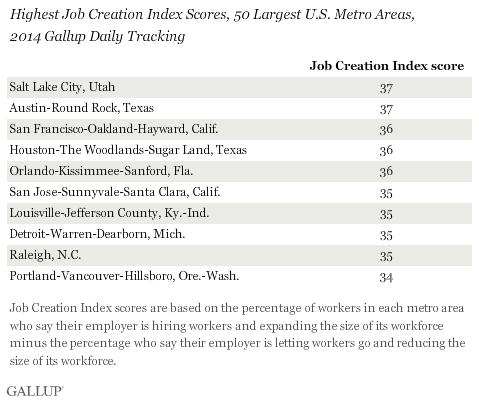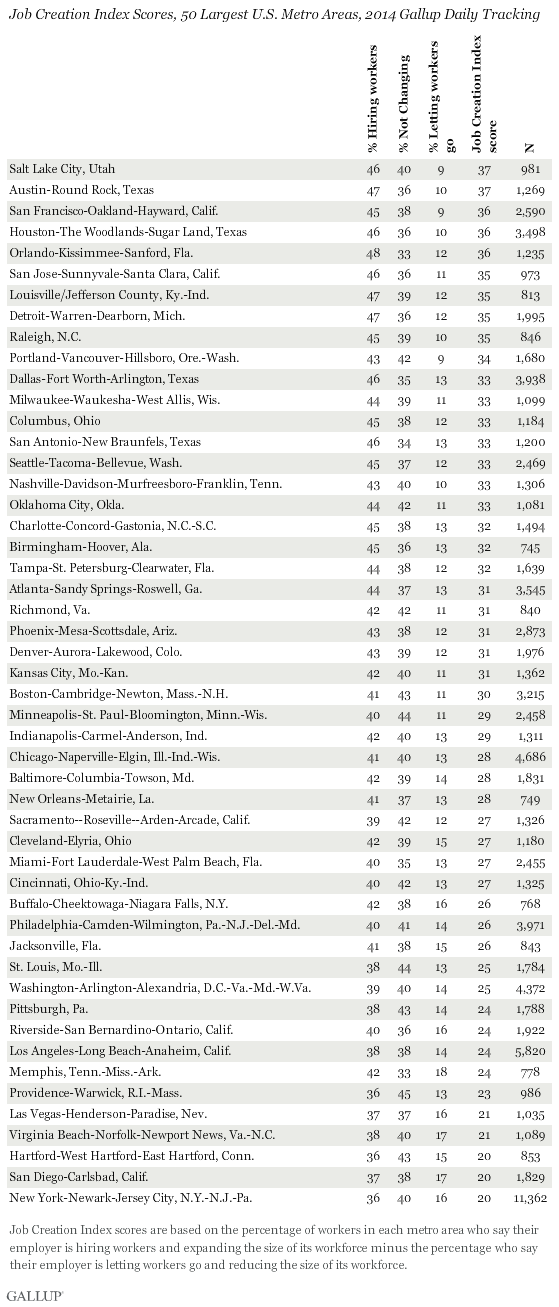Story Highlights
- Austin, Salt Lake Job Creation Indexes are +37
- New York, Hartford, San Diego lag in job creation
- Most large MSAs have above-average job creation
PRINCETON, N.J. -- Austin, Texas, and Salt Lake City have the highest Job Creation Index scores among the 50 largest U.S. metro areas, based on employee reports of hiring activity where they work. San Francisco, Houston and Orlando rank just behind Austin and Salt Lake City in job creation.

Many of the top-ranking metro areas are being boosted by growth in technology jobs, including traditional tech centers in San Francisco and San Jose but also emerging ones in Austin and Salt Lake City. These latter two may be increasingly attractive destinations for tech workers, given salaries that are becoming more competitive for the industry, along with a much lower cost of living than in California. Salt Lake City is also benefiting through growth in tourism and energy sector jobs. The growth in job creation in both Austin and Salt Lake City also spills over into growth in housing and construction jobs to meet the basic needs of the growing workforce in those areas.
The results are based on Gallup Daily tracking conducted throughout 2014. Gallup asks working Americans to say whether their employer is hiring workers and expanding the size of its workforce, not changing the size of its workforce, or letting workers go and reducing the size of its workforce. Overall, throughout 2014, an average of 39% of U.S. workers said their employer was hiring workers, compared with 13% who said their employer was letting workers go, resulting in a nationwide Job Creation Index of +26. Reports of job creation are currently quite strong and have improved each year since 2009.
Gallup assigns respondents to metro areas using the definitions for Metropolitan Statistical Areas developed by the federal Office of Management and Budget. Each MSA sample is weighted to ensure it is representative of the population of that metro area. Sample sizes range from a low of 745 for Birmingham, Ala., to a high of 11,362 for the New York City metro area.
Hiring activity appears to be a bit stronger in the larger U.S. metro areas than in the U.S. as a whole, given that all but 15 of the 50 most populous metro areas have Job Creation Index scores higher than the +26 national average. The full data for each of the largest metro areas appear at the end of the article.
The areas with the lowest index scores among the top 50 MSAs are New York, San Diego and Hartford, Conn., at +20, and Virginia Beach-Norfolk, Va., and Las Vegas at +21. Although these scores are the lowest in a relative sense, they are still strong in an absolute sense.

San Diego and Virginia Beach-Norfolk have large military presences, so reductions in defense spending could be limiting job growth in those areas.
Houston, Salt Lake, Orlando Consistently Among Job Creation Leaders
Gallup previously assessed job creation by metro area for 2012 and 2013 combined. Houston led the other metro areas for that two-year period, but despite an increase in its Job Creation Index score, it was edged out by Salt Lake City and Austin this year. Houston, along with Salt Lake City and Orlando, has ranked among the top five metro areas for both 2012-2013 and 2014.
Meanwhile, New York and San Diego ranked near the bottom in both reports. This is in spite of significant improvement in the Job Creation Index scores for both metro areas this year, including a seven-point increase for New York (from +13 to +20) and an eight-point increase for San Diego (from +12 to +20).
More broadly, each of the 50 largest metro areas had at least a nominal increase in its Job Creation Index score, with the average improvement being eight points. The metro areas with the largest improvements since 2012-2013 are Raleigh, N.C., at 14 points, and Sacramento, Calif.; Portland, Ore.; and Detroit, Mich., at 13 points each. After the improvements, Raleigh, Portland and Detroit now rank among the leading MSAs in job creation. Sacramento had one of the lowest job creation scores in 2012-2013, and now ranks in the middle of the pack.
Implications
The U.S. job market has steadily improved since the depths of the 2008-2009 recession, and the largest metro areas have tended to show an even better job situation than the country as a whole. In particular, metro areas with strong or emerging technology industries rank among those with the greatest hiring activity, based on workers' reports of what is happening at their own workplaces. Metro areas that are successful in attracting workers in a certain growth industry -- be it technology, energy or health -- will likely reap even greater benefits as the growing job base has snowball effects that lead to job creation in industries, like construction, to support the growing workforce living there.
Survey Methods
Results for this Gallup poll are based on telephone interviews conducted in 2014, on the Gallup U.S. Daily survey, with a random sample of 201,254 employed adults, aged 18 and older, living in all 50 U.S. states and the District of Columbia. For results based on the total sample of workers, the margin of sampling error is ±1 percentage point at the 95% confidence level.
For results based on MSA-level data, the margin of sampling error is no more than ±4 percentage points at the 95% confidence level, and is ±3 percentage points for most MSAs. Respondents are assigned to metro area using OMB definitions of metropolitan statistical areas.
All reported margins of sampling error include computed design effects for weighting.
Each sample of national adults includes a minimum quota of 50% cellphone respondents and 50% landline respondents, with additional minimum quotas by time zone within region. Landline and cellular telephone numbers are selected using random-digit-dial methods.
Learn more about how Gallup Daily tracking works.


